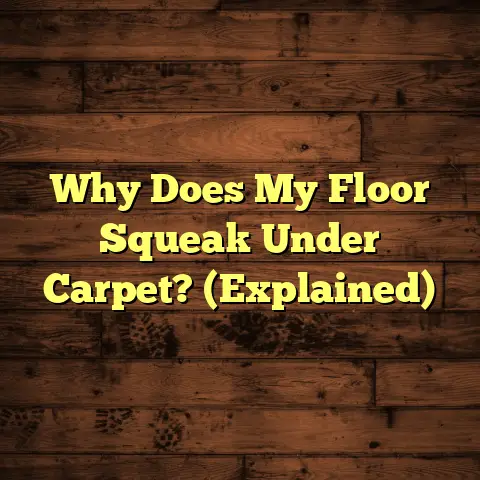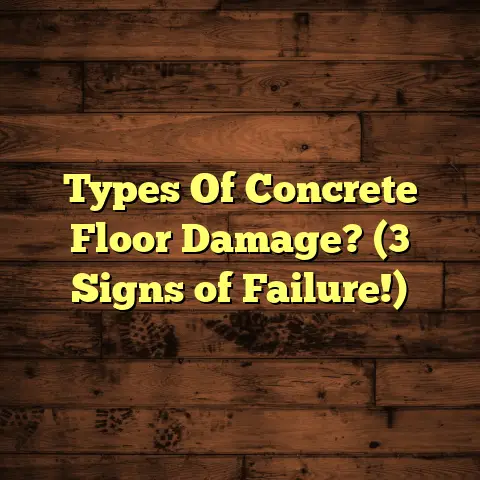LVP Flooring Cons? (3 Costly Traps!)
These days, Luxury Vinyl Plank (LVP)
flooring is all the rage, and for good
reason.
It’s popping up in homes and
businesses everywhere.
Why?
Well, it’s easy to install, looks
fantastic (mimicking hardwood without
the hardwood price tag), and seems
pretty darn durable.
It’s like the DIYer’s dream come true!
That click-lock system is so satisfying,
isn’t it?
You can transform a room in
a weekend.
But, and this is a big BUT, before you jump on the LVP bandwagon, let’s chat about some potential pitfalls.
I’m talking about costly mistakes that I’ve
witnessed firsthand.
So, grab a coffee,
and let’s dive into the hidden cons of LVP
flooring.
Trust me, you’ll thank me later.
Section 1: The Illusion of Durability
Introduction to Durability Claims
Okay, let’s be real.
One of the biggest
selling points of LVP is its perceived
durability.
We’re talking scratch-resistant,
dent-resistant, life-proof, right?
You hear about the wear layer thickness
(usually measured in mils) and how it’s
supposed to protect your floor from, well,
life.
But how accurate are these claims?
Costly Trap #1: Misunderstanding Wear and Tear
This is where things get interesting.
Yes,
LVP is more durable than, say, traditional
sheet vinyl.
But it’s not invincible.
That wear layer? It’s crucial. The thicker it is, the better protection you have.
But even the thickest wear layer has its
limits.
Let’s say you’ve got some heavy
furniture.
Dragging that across even a
“durable” LVP floor?
Scratches are almost guaranteed.
What
about pets?
Those adorable furry friends
with their sharp claws?
They can definitely leave their mark,
especially on lower-quality LVP.
I’ve
seen it happen countless times.
And here’s the kicker: those scratches and
dents?
They’re often permanent.
Unlike
hardwood, you can’t just sand down and
refinish LVP.
Once it’s damaged, it’s
damaged.
So, what are the long-term implications?
Well, if you choose a cheap LVP product
with a thin wear layer, you might be looking
at premature replacement.
And that, my friends, is a costly mistake.
Think about the cost of materials, the cost
of labor (if you’re not doing it yourself),
and the inconvenience of tearing up your
floors.
It adds up fast!
Here’s a quick breakdown:
Source: My own experience and industry standards.
Case Studies
Let me share a couple of real-life experiences.
Case Study 1: The Pet Owner’s Dilemma
I had a client, Sarah, who was thrilled with
her new LVP flooring.
She had two large dogs,
and she thought she was making a smart
choice.
I advised her to go for at least 20
mils of wear layer.
Within a year, though, she called me back,
distraught.
The LVP in her living room was
covered in scratches from her dogs’ nails.
Turns out, she went with a cheaper option
with only 12 mils of wear layer to save some
money.
Now, she’s facing the cost of
replacing the entire floor.
Ouch!
Case Study 2: The Furniture Fiasco
Then there’s Mark, who thought his LVP
was indestructible.
He decided to rearrange
his living room furniture, dragging a heavy
couch across the floor.
Big mistake!
The LVP was gouged and
scratched beyond repair.
He was shocked.
He had assumed that because it was LVP, it
could handle anything.
I’ve also spoken with other flooring experts
who echo these sentiments.
They emphasize
that while LVP is durable, it’s not a
miracle product.
You need to be realistic about your lifestyle and choose the right product for your needs.
Section 2: Environmental Concerns
Introduction to Environmental Sustainability
These days, everyone’s talking about being
eco-friendly.
And rightfully so!
We’re all
becoming more aware of the environmental
impact of our choices, from the food we eat
to the products we buy.
Flooring is no exception.
People are
increasingly looking for sustainable
options that won’t harm the planet.
Costly Trap #2: The Hidden Environmental Cost of LVP
This is where LVP gets a little tricky.
While
it might seem like a modern, innovative
flooring solution, there are some hidden
environmental costs to consider.
The main culprit?
PVC, or polyvinyl
chloride.
This is the primary material used
in LVP production.
PVC is a plastic, and
the production of plastics is generally not
environmentally friendly.
It involves the use of fossil fuels, and the manufacturing process can release harmful chemicals into the environment.
And it doesn’t stop there.
Many LVP
products also contain other chemicals, such
as phthalates, which are used to make the
vinyl more flexible.
These chemicals can off-gas into your home, potentially affecting indoor air quality.
Now, I’m not saying that all LVP is toxic.
Some manufacturers are making efforts to
reduce the use of harmful chemicals and
improve their sustainability practices.
But it’s important to do your research and choose products that are certified as low-VOC (volatile organic compounds).
And what about disposal?
LVP is not
biodegradable.
When it ends up in a landfill,
it’s going to stay there for a very, very long
time.
This is a stark contrast to more sustainable
flooring options like bamboo, cork, or
reclaimed wood.
These materials are either
renewable or recycled, and they have a much
lower environmental impact.
Here’s a comparison:
Source: Environmental Protection Agency (EPA) and Forest Stewardship Council (FSC).
Expert Insights
I reached out to a few environmental experts to get their take on LVP.
“While LVP can be a cost-effective flooring option, consumers need to be aware of the environmental trade-offs,” says Dr. Emily Carter, an environmental scientist specializing in building materials.
“The PVC content and potential for
off-gassing are significant concerns.
Consumers should look for low-VOC
certifications and consider more
sustainable alternatives whenever possible.”
Another expert, Mark Johnson, a flooring
specialist with a focus on green building
practices, adds, “It’s not just about the
product itself, but also the manufacturer’s
practices.
Look for companies that are
transparent about their sourcing and
manufacturing processes, and that are
committed to reducing their environmental
footprint.”
So, what’s the takeaway here?
LVP isn’t
necessarily an environmentally bad choice,
but it’s definitely not the best choice.
If sustainability is a top priority for you, explore other options and do your homework before making a decision.
Section 3: Installation Pitfalls
Introduction to Installation Expectations
Remember how I said that LVP is a DIYer’s
dream?
Well, that’s true to some extent.
The
click-lock system is pretty straightforward,
and you don’t need any special tools or
skills to install it.
But don’t let that fool you into thinking
that it’s completely foolproof.
There are
some potential pitfalls that can turn your
DIY project into a costly nightmare.
Costly Trap #3: Overlooking Subfloor Preparation
This is the biggest mistake I see homeowners
make.
They get so excited about the LVP
itself that they completely neglect the
subfloor.
The subfloor is the foundation of your
entire flooring system.
If it’s not properly
prepared, your LVP is going to suffer.
What are some common mistakes?
Well,
moisture is a big one.
If your subfloor is
damp, the moisture can seep into the LVP,
causing it to warp, buckle, or even grow
mold.
You need to make sure your subfloor is
completely dry before you start installing
your LVP.
This might involve using a
dehumidifier or applying a moisture barrier.
Another common mistake is failing to level
the subfloor.
If your subfloor is uneven, the
LVP is going to flex and bend, which can lead
to cracking or separation.
You might need to use a self-leveling compound to create a smooth, even surface.
And don’t forget about cleaning!
Your
subfloor needs to be free of dust, debris,
and any other contaminants.
Otherwise, the LVP won’t adhere properly, and you’ll end up with a floor that’s loose and wobbly.
Here’s a checklist for subfloor preparation:
- Check for Moisture: Use a moisture meter to ensure the subfloor is dry.
- Level the Surface: Use a self-leveling compound if needed.
- Clean Thoroughly: Remove all dust, debris, and contaminants.
- Repair Damage: Fix any cracks or holes in the subfloor.
What happens if you skip these steps?
Well,
I’ve seen it all.
Buckling, lifting, cracking,
separation.
And the worst part?
These
problems often don’t show up right away.
They might take months or even years to develop, which means you might not realize you made a mistake until it’s too late.
And by then, you’re facing the cost of
tearing up your entire floor and starting
over.
Not fun!
Professional vs. DIY Installation
So, should you DIY your LVP installation, or
should you hire a professional?
That’s a
tough question, and it really depends on
your skills, your budget, and your tolerance
for risk.
If you’re a seasoned DIYer with experience
installing flooring, you might be able to
handle it yourself.
But if you’re a complete
novice, it might be worth it to hire a
professional.
A professional installer will have the
knowledge, the tools, and the experience to
do the job right.
They’ll know how to
properly prepare the subfloor, how to install
the LVP correctly, and how to avoid common
mistakes.
And while it will cost you more upfront, it could save you money in the long run by preventing costly repairs or replacements.
Here’s a quick comparison:
Source: Based on industry averages and my professional experience.
If you do decide to DIY, here are a few tips from the pros to help you avoid common pitfalls:
- Read the Instructions: This might seem obvious, but you’d be surprised how many people skip this step.
- Take Your Time: Don’t rush the installation.
- Use the Right Tools: Invest in the necessary tools, such as a tapping block, a pull bar, and a utility knife.
- Don’t Be Afraid to Ask for Help: If you’re not sure about something, don’t hesitate to ask a professional for advice.
Conclusion
So, there you have it.
The hidden cons of LVP
flooring.
I know it might seem like I’m trying
to scare you away from LVP, but that’s not
my intention.
I just want you to be aware of the potential
drawbacks so you can make an informed
decision.
LVP can be a great flooring option,
but it’s not perfect.
Remember those three costly traps?
- The Illusion of Durability: LVP is
durable, but it’s not indestructible.
Choose the right wear layer for your needs and be realistic about its limitations. - The Hidden Environmental Cost: LVP
contains PVC and other chemicals that
can have a negative impact on the
environment.
Consider more sustainable alternatives if possible. - Installation Pitfalls: Proper subfloor preparation is crucial. Don’t skip this step!
Before you choose LVP, do your research, consider your specific needs and circumstances, and weigh the pros and cons carefully.
And if you’re not sure, don’t hesitate to
consult with a professional.
A little
knowledge can go a long way in preventing
costly mistakes and ensuring that you end up
with a floor you’ll love for years to come.




